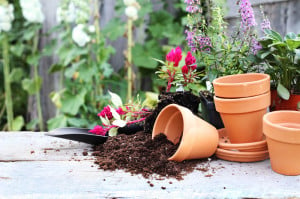Best Soil Types For Plant Containers
If you are under the impression that all soil types are created equal, think again. There are MANY different soil types on the market, each with a specific material content and purpose. Picking the wrong kind of soil, or not properly caring for the soil you select, can cause otherwise healthy plants to fall ill, as soil can impact a plants ability to capture sunlight, water, and vital nutrients. The same soil cannot serve a plant forever either; in fact most soil goes bad after about 2 years and needs to be replaced. Even experienced gardeners often struggle with soil; here we provide answers to basic soil questions and how to select the best soil for your plant containers.
How To Identify Different Soil Types
All soil types have their own differentiating characteristics that set each type and brand apart, for instance the shape and size of the granules vary widely, as well as the nutritional and mineral makeup. A key mitigating factor is the acidity level present in soil, this is measured using a pH scale that runs 1-14, the lower a soil’s number is, the higher its acid content registers. The higher a soil is rated on the pH scale, the more alkaline rich the soil is. Generally, plants prefer a pH reading of around 6.2 to 6.7, although not all plants are the same. Determining the pH levels your plants crave is key to picking appropriate soil.
Soil is generally derived of clay, sand, and silt; the exact soil content will dramatically change the nutrition a soil provides, which will have a big impact on your plants. Some soil types quickly run dry, while others retain water all year long. While the original soil that you purchase is important, it’s imperative to note that soil can change due to too much rain, not enough rain, and many other environmental factors. Learn about 10 different soil types and when to use them by going HERE.
Tricks For Adding Nutrients To Your Soil
Never assume that all soil is packed with nutrients, in fact beware of soil that possesses virtually no nutrients at all. Some topsoil is simply dirt and needs added organic materials to benefit your landscaping. There are a number of ways to add nutrients to your soil, including keeping a compost pile that you can regularly add to soil. If properly kept, a compost pile can be small and doesn’t have to smell, you can also purchase small compost tumblers to keep animals (both stray and domesticated) out. You can add all sorts of things to a compost pile, including leftover leaves and twigs from plants that have already flourished, just don’t add any diseased plants to your compost pile.
For another burst of plant nutrients, you can skip the compost pile and simply add a bag of rock phosphate to your soil about every 2 years. Over time rock phosphate slowly deliver nutrients to your plants, and while many gardeners forget to add it, it can make all the difference in the final outcome. With the help of rock phosphates plants mature quicker and grow larger, and they are also less susceptible to a number of diseases including summer drought, and frost. 6 Tips on Building Soil

The Importance of Soil Texture
When picking the right soil for your potted plants, think of it like this: the roots of a plant need to stretch deep down into the soil to collect water and grow a strong root base. Therefore, tightly packed soil can make a plant’s life complicated, as a lot of plant energy must be dedicated to pushing down through practically immobile soil. Slide your own hands down into the soil to see how loose it is; lightly packed soil that is crumbly is best. When roots can easily grow, more energy can be preserved towards the growth and beauty of any plant.
Picking The Right Soil Types For Your Plant Containers
Some potted plants will thrive in one soil type, while other plants will wither away as if you never cared for them at all. For instance, a chalky soil will not work so well when it comes to flowers that are brightly colored, take rhododendrons for instance. Yet, other plants thrive in the high alkaline environment provided by chalky soil, such as lilies, lilacs, and other flowering shrubs. Chalk soil is found deeply buried underground, it becomes sticky when wet and is known to dry out rapidly when left in the heat. Low moisture paired with the presence of high lime levels makes chalky soil high in alkaline (pH 7.5 of higher). Low moisture retention and high pH levels can disrupt the natural growth of some plants, although this can be somewhat offset by adding peat, manure, or compost to your soil. On the other end of the spectrum is silt-based soil; this is a very fine type of soil that can be compacted easily. Silt soil has high water retention, making it great for water-loving plants, think: brightly colored vines and grasses, along with colorful flowers.
Of course, these are only 2 many soil types available. By doing some research on the particular plants throughout your landscaping you can find the best soil types for each plant type. For successful landscaping results, the goal is to find the right soil, and then maintain this soil so that it promotes the health and growth of your potted plants. Tips for Growing Healthy Plant Containers!

